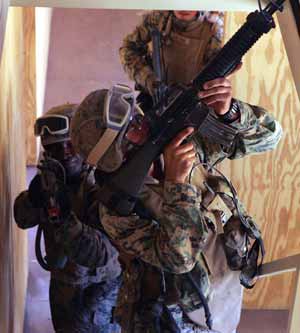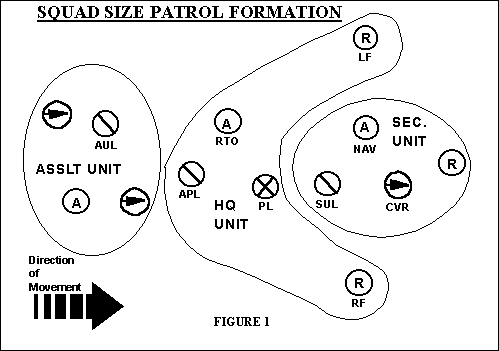|
Medical Education Division |
Operational Medicine 2001
Field Medical Service School
Student Handbook

|
PATROLLING ďTake
your time. Stay away from the easy
going. Never go the same way
twice.Ē Gunnery
Sergeant Charles C. Arndt
TERMINAL LEARNING OBJECTIVES 1.
Given a
combat environment (day and night), a patrol order, and individual combat
equipment, participate in a patrol per the references.
(FMST .02.01) ENABLING
LEARNING OBJECTIVES 1.
Without
the aid of reference materials, from a list provided, select the definition of
the term patrol, per the student handout. (FMST.02.01a) 2.
Without
the aid of reference materials, from a list provided, select two (2) types of
patrols, per the student handout. (FMST.02.01b) 3.
Without
the aid of reference materials, from a list provided, select the mission of
patrols, per the student handout. (FMST.02.01c) 4.
Without
the aid of reference materials, from a list provided, select the organizational
elements of a patrol, per the student handout.
(FMST.02.01d) 5.
When
directed, participate in the conduct of a patrol, per instruction.
(FMST.02.01e) 6.
When
directed, participate in debriefing of a patrol, per instruction.
(FMST.02.01f) OUTLINE
A.
DEFINITION. A patrol is a detachment of ground forces sent out by a
larger unit for the purpose of:
B.
MISSIONS
AND TYPES OF PATROLS
a.
Area
reconnaissance. An area reconnaissance is a directed effort to obtain detailed
information concerning specific terrain or enemy activity within a specific
location (i.e., bridge, road junction), or enemy activity critical to
operations. b.
Zone
reconnaissance. A zone reconnaissance is a directed effort to obtain detailed
information concerning all routes, obstacles, terrain, and enemy forces within a
particular zone defined by specific boundaries. c.
Route
reconnaissance. A route reconnaissance is a reconnaissance along a specific
line of communication, such as a road, railway, or waterway, to provide
information on conditions and activities along the route.
a.
Raid. Raid patrols destroy or capture enemy personnel or equipment,
or destroy installations, and then conducts a PLANNED withdrawal. b.
Ambush. Ambush patrols carry out surprise attacks from a concealed
position on enemy patrols, carrying parties, foot columns, and convoys. c.
Contact. Contact patrols establish and maintain contact with friendly
or enemy forces. d.
Economy
of force. Economy of force patrols perform limited objective missions
such as seizing and holding key terrain to allow maximum forces to be used
elsewhere. e.
Security
Patrols. Security patrols screen flanks, areas, and routes to prevent
infiltration and protect against ambush or surprise.
Security patrols are the most common type of combat patrol. C.
ORGANIZE
THE PATROL. The patrol leader task organizes the patrol into units and
teams required to accomplish the mission.
a.
The headquarters
unit is assigned tasks associated with controlling the patrol.
The headquarters unit includes the patrol leader, assistant patrol
leader, radio operator, flank security, and corpsman. b.
The security
unit provides security for the patrol during movements and at the
objective area. c.
The
assault unit is tasked with actually engaging the enemy. d.
The support
unit provides supporting fires for the assault unitís attacks and
covering fires if required for its withdrawal.
It also provides cover when crossing danger areas. D.
ORGANIZATION
FOR MOVEMENT. Organization for movement is based on the patrol leaderís
estimate of the situation. Other
factors that will influence the patrolís formation are speed, flexibility,
control, and all around security.
E.
CONTROL. The success of a patrol can depend on the ability of the
patrol leader to communicate his plan and to effectively integrate the actions
of his subordinate units throughout the preparation and conduct phases of the
patrol.
F.
SECURITY
AND MOVEMENTS
G.
HALTS
Figure
2. H.
RALLY
POINTS
I.
DANGER
AREAS
a.
Linear
danger area. A linear danger area is any location where a patrol is
vulnerable to enemy observation or fire predominately from the flanks, such as
trails, roads, or streams. b.
Cross-compartment
danger areas.
A cross-compartment danger area is any location where a patrol is
vulnerable to enemy observation or fire from the front and flanks.
The patrol is placed at a positional disadvantage along its direction of
movement, such as when moving through a draw. REFERENCE: Marine
Rifle Squad, FMFM 6-5 Marine
Rifle Platoon/Company, FMFM 6-4 Field Medical Service School
Approved for public release; Distribution is unlimited. The listing of any non-Federal product in this CD is not an endorsement of the product itself, but simply an acknowledgement of the source. Operational Medicine 2001 Home ∑ Military Medicine ∑ Sick Call ∑ Basic Exams ∑ Medical Procedures ∑ Lab and X-ray ∑ The Pharmacy ∑ The Library ∑ Equipment ∑ Patient Transport ∑ Medical Force Protection ∑ Operational Safety ∑ Operational Settings ∑ Special Operations ∑ Humanitarian Missions ∑ Instructions/Orders ∑ Other Agencies ∑ Video Gallery ∑ Phone Consultation ∑ Forms ∑ Web Links ∑ Acknowledgements ∑ Help ∑ Feedback
*This web version is provided by The Brookside Associates Medical Education Division. It contains original contents from the official US Navy NAVMED P-5139, but has been reformatted for web access and includes advertising and links that were not present in the original version. This web version has not been approved by the Department of the Navy or the Department of Defense. The presence of any advertising on these pages does not constitute an endorsement of that product or service by either the US Department of Defense or the Brookside Associates. The Brookside Associates is a private organization, not affiliated with the United States Department of Defense. |



